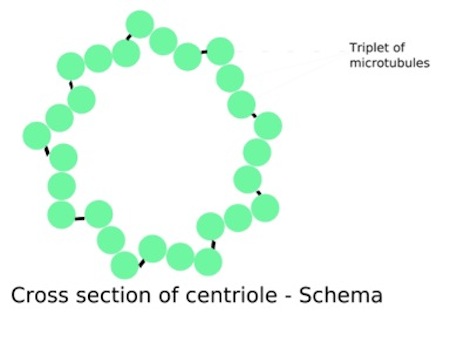 Evolution
Evolution
 Intelligent Design
Intelligent Design
Centrioles: Elegant Cartwheels Come Into Focus
Centrioles are organelles involved in cell division and the construction of cilia and flagella. How they work is unknown, but using new imaging techniques, a research team has unveiled their complex structure in more detail than ever before.

You can’t look at an electron micrograph of a centriole in cross-section and not be struck by its beautiful radial symmetry — a highly ordered structure that really stands out from the background. Constructed of rod-like microtubules, most centrioles have a nine-fold pattern, nine triplets or doublets evenly spaced at the rim, giving it a “cartwheel” appearance in cross-section. The side view shows it to be a cylinder, about 500 nm long and 250 nm wide. In the centrosome, two centrioles reside at right angles to each other, connected at one end by fibers.

These architecturally perfect structures are essential in many animal cells and plants (though not in flowering plants or fungi, or in prokaryotes). They help organize the centrosomes, whose spindles of microtubules during cell division reach out to the lined-up chromosomes and pull them into the daughter cells. They also form the basal bodies of cilia and eukaryotic flagella. They help establish the left-right axis during embryonic development in animals. Interestingly, they undergo their own division process apart from DNA replication. Centrioles are “highly conserved” from protists to humans. Mutations in centrioles are implicated in some serious diseases, if the embryo survives at all.

The basic cross-sectional structure of a centriole has been known since the late 1800s, but new features continue to come to light. Now, a team from Switzerland and Japan, reporting in Current Biology, has revealed this wonderful structure in unprecedented detail using cryotomography. It’s like going from seeing an out-of-focus motorcycle wheel from a distance to seeing it up close and noticing all kinds of new structures. The pictures are worth a thousand words — that is one intricate device!
They found new structures and gave names to them: the pinhead, the pinfeet, the A-C linker, the Cartwheel Inner Densities (CID), and more. One of their findings was that the central hub has the same 9-fold radial symmetry as the spokes that link to the rim triplets. Another is that the entire structure has some polarity or chirality; if you turned the centriole over, the inside wouldn’t orient the same way. Some of the linkers are at angles along the radial axis.
The inner hub and spoke structure is really elegant. Stacks of 9-fold rings, each with their own linkers and “pinheads,” merge as they extend out to the rim. The triplets at the end of each radial spoke appear just as precise, as if crafted in a machine shop.
It wasn’t the goal of the authors to uncover the mechanism by which these machines operate. That’s still somewhat of a mystery. How are they assembled? How do they duplicate themselves? How do they work? Discovery Institute’s Dr. Jonathan Wells hypothesized years ago that centrioles operate like winches, pulling the chromosomes apart with force (see here and here). This new paper did not address that question, but surely something this finely crafted has a great scientific story to tell. As for evolution, the only times the authors mentioned it, they referred to the “evolutionary conservation” of the overall architecture and individual parts.
Since the centriole appears fully formed in the simplest eukaryotic cells, and is “highly conserved” (not evolved) from microbes to humans, a design-theoretic approach to understanding its operation would surely prove more fruitful than the assumption that this marvel of craftsmanship “arose” through unguided processes.
Images: Wikicommons.
